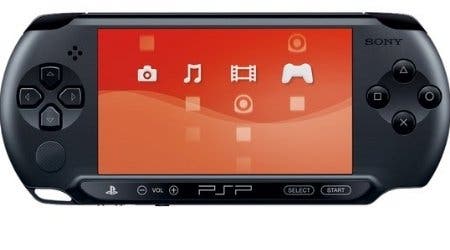PSP E-1000 Review
The last hurrah.
Almost seven years after its debut in Japan, Sony has released the latest - and final - iteration of its venerable PlayStation Portable handheld. The new E-1000 is a cut-down budget model available in stores now for just £85. Is it an example of cost-cutting too far, or is it a sparkling return to form after the ill-advised PSPgo and the disappointing PSP-3000?
First impressions of the new handheld are intriguing. The design is more consistent with the PlayStation 3 Slim, featuring glossy d-pad and buttons placed against a matte 'charcoal black' outer casing. Build quality is rather solid, although the new matte finish has a slightly cheap look about it in the flesh and the unit clearly lacks the more 'high-end' refinement seen on past PSP models.
That said, the shiny menu bar along the bottom is a nice touch: you'd be easily fooled into thinking this was a touch panel, but unfortunately it isn't. Instead we have a rubber surface that depresses to reveal an underlying set of clicky buttons: a bit agricultural perhaps in this touch-driven age, but solid nonetheless.
Those who preferred the chunkier design of the original PSP will be right at home here: the E-1000 apes the original design very closely. The unit is almost exactly the same shape - though the menu panel at the bottom is slightly more raised on the E-1000, and the curved underside is now completely flat. As a result it feels more refined and slightly less bulky, but is very, very similar indeed overall. However, the new unit weighs considerably less, making it easy to hold for longer periods of time, although it lacks the notably lightweight feel of either of the 'Slim and Lite' models.

E-1000 Design: The Nitty-Gritty
Placement of the power buttons, memory card slot and other similar features have also been shunted around. The power button finds itself positioned on the bottom of the unit, on the left hand side next to the headphone jack, while the memory card slot and power light are now found on the top, next to the USB connection. The PSU input remains where it was in the other PSP models, strangely detached from the power light on the E-1000. As the unit lacks all wireless capabilities, the WLAN switch is gone and the in-built microphone used for chat across Skype on the PSP-3000 is also absent for the very same reason.
On the menu bar we have the volume controls, start and select buttons, along with the PS branded home button. The control for adjusting screen brightness is absent and is now found in the XMB menu under Power Save Settings. There are three levels of brightness with the lowest being most suitable for general use in a range of different conditions. The next level up works well for very bright environments, while max brightness washes out the screen a little bit too much for our liking.
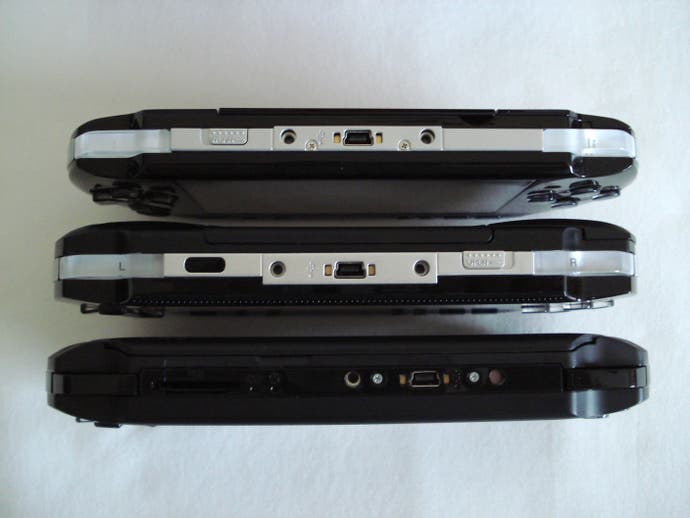
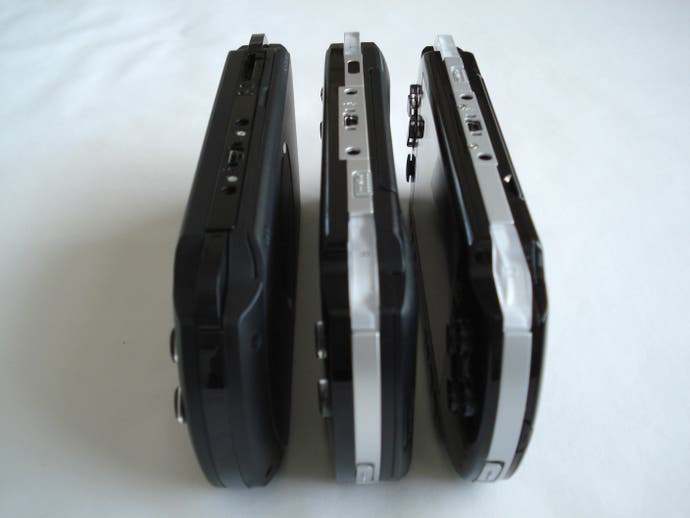
The UMD drive and battery are located around the back of the E-1000. In fact, the new UMD drive door extends right across the rear of the unit, making it more prone to accidentally being broken than on the other PSP models if the device was to be dropped (no, we did not try this). It certianly feels a little filmsy in comparison, even compared to the unsubstantial PSP-2000 and 3000 offerings. There's no catch to unlock the drive either, as there was on the original 'fat' model - the back simply pulls out manually, just like the Slim models.
Despite being visible when you open up the UMD drive, the battery appears to be fixed into place and cannot be swapped out as per the other PSP models: a telling sign is that the battery comes pre-installed and that the instruction booklet advises you to contact Sony in the event of battery failure. This means that those looking to extend battery life with a larger capacity battery are plain out of luck.
Cost-cutting measures can also be found in one or two areas of the unit: for example, the memory card slot on the top is exposed while the console only features a singular mono speaker in lieu of the stereo set-up present on previous models. As a result, sound quality is less dynamic due to there being no separation between the left and right channels, although the new speaker does deliver a pleasing mix that avoids sounding flat - audio is actually quite crisp. Thankfully you can still connect up a decent pair of headphones or a set of external speakers to the 3.5mm jack, thus giving you the same stereo experience as previous PSPs, so this is hardly a deal breaker.
The more eagle-eyed may note that the remote socket is now absent, so sticking this PSP in your pocket and using it as a music player is now less user-friendly. It also means that the video output facilities of the PSP-2000 and PSP-3000 are now gone - not a deal-breaker for most, but a nicely implemented feature we're sorry to see the back of.
Screen Quality
Screen quality is something of an issue for us, bearing in mind how badly the PSP-3000 performed in this regard. The use of a wider colour gamut to enhance some PSP titles was appealing, but we weren't particularly thrilled with what looks for all the world like an interlaced display. Noticeable scanlines are visible on the screen during fast motion content, making games like Ridge Racer and Gran Turismo less fun to play as the additional artifacts tend to intrude on the action.
The good news with the E-1000 is that the screen is progressive, so the scanline problem of the 3000 model is completely gone. The wider colour gamut also appears to have gone too, but this isn't necessarily a bad thing as this led to some games looking unnaturally oversaturated when viewed on the PSP-3000's screen. However, colours on the E-1000 do appear pleasingly more vibrant than on the original 1000 model, without making things look overblown. Rather than featuring a wider colour gamut, calibration differences along with a lower gamma setting are the most likely causes here.

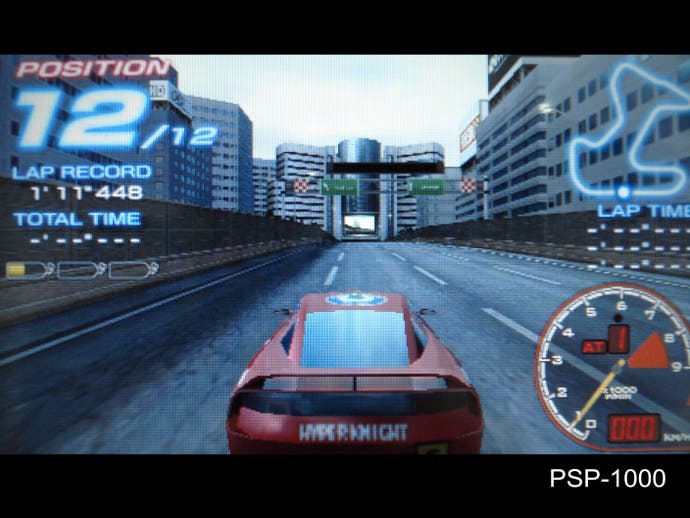

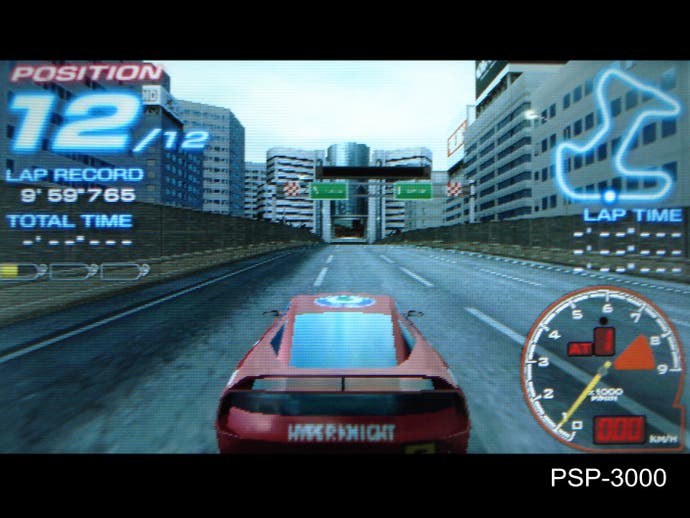
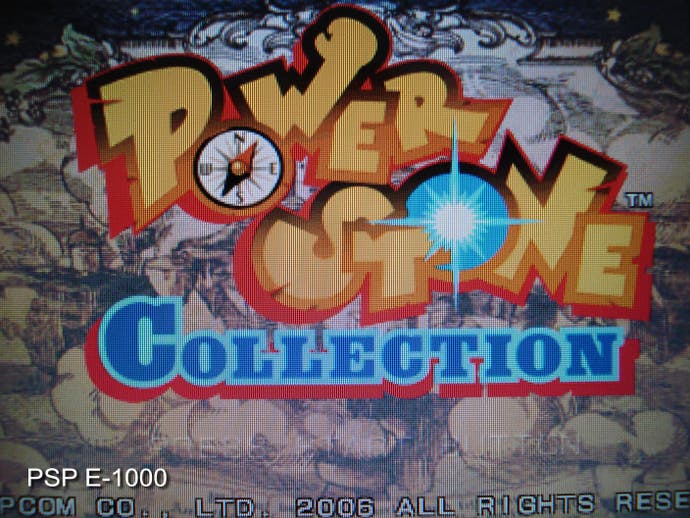
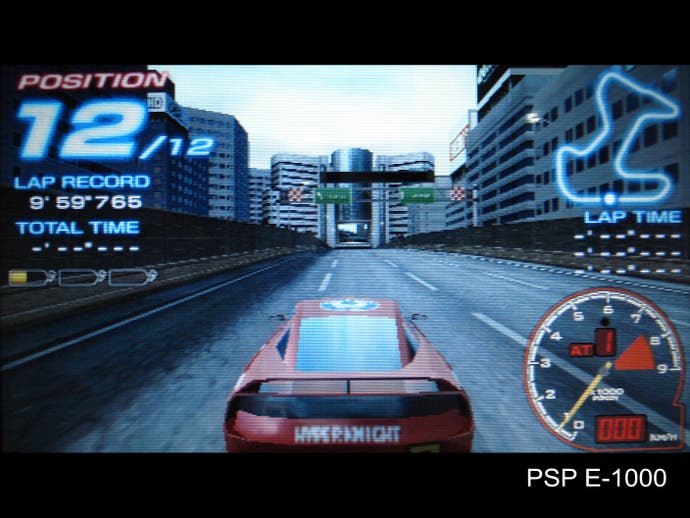
So, what we have here looks like a 'best of' when it comes to PSP screens. However, things aren't perfect. A dithering effect is present and seems to manifest itself as a series of noisy vertical strips across the screen, which can mainly be seen on plain backgrounds or artwork made up of single colours. There's also a noticeable screen-door effect which emphasises pixel structure more than previous PSP screens. In all fairness though, we easily rate the E-1000's screen over that of the 3000, but the 2000 Slim & Lite model perhaps offers up the best display by presenting us with the cleanest image and no interlacing/scan-lines.
Operation
In terms of operation, the inclusion of PSP-3000 style d-pad and face buttons is a nice touch. Pulling off combos and more complex moves in games like Tekken didn't present us with much of a problem, with button presses feeling smooth and responsive, while the L and R shoulder buttons feel much the same as on the 3000. On the other hand, the analogue slider pad felt a bit stiffer compared to those on our other PSPs. To be honest, this is more likely down to the E-1000 being 'brand new' than a design issue - all of our other PSPs have had a lot more use, and thus the slider has had chance to wear in.
One thing we were pleased about is that the matte finish of the unit surrounding the d-pad and buttons has a tangible benefit to the player. Specifically, the textured surface gives your fingers a more controlled grip, with there being less chance of them slipping away from the d-pad in heated moments when playing fast-paced games - though the pad itself is still glossy and prone to slip.

Elsewhere, the lack of any kind of wireless connectivity may strike you as a bit of a blow where functionality is concerned - the web browser is gone and you can't download games from the PlayStation directly with the unit alone. In terms of loading up PSN titles for play on the console, this has to be done on the PC, with the PSP being plugged in via USB in order to transfer the content over to the memory stick. However, the E-1000 is being positioned as a low-budget option for those looking at getting the handheld for its basic gaming, music, and movie watching purposes, and not as a direct replacement for the PSP-3000, which should still be available both in stores and online. Perhaps the biggest blow here is that it means that multiplayer gaming won't work.
While we do miss the ability to check up on new releases and demos on the PlayStation Store without needing to be tethered to a fixed online connection, we can't say that the lack of web browsing or Skype functionality is an issue - these are both things that even entry-level smartphones can do much better than the PSP. In any case, if having a broader range of features is important to you, you can simply go for the more expensive PSP-3000 option or pick up an older, second-hand unit.
Battery Life
Moving onto battery life, and the results aren't particularly surprising. Throughout our tests we paused to change game and powered down the unit a few times to try and reflect real-world usage - usually play time is slightly longer when draining the battery in one sitting, as booting up of the unit in theory should result in slightly more power being expunged from the battery.
In total we managed to get around 6 hours and 11 minutes of playtime with the screen brightness set at its lowest level (suitable for most conditions) before needing to re-charge the unit, roughly in-line with Sony's own quoted figures. Our tests included playing games and watching a few movies from the memory stick.
Given the fact that the mechanical nature of the UMD drive helps to quickly gobble up battery life, it's hard to expect longer usage considering the constraints of the system's design - although bearing in mind that there's no WiFi adaptor, and only one speaker, we're not surprised that overall battery life is perhaps slightly longer than previous PSPs in similar conditions. So in that respect, it certainly isn't bad, and probably the best we can hope for seeing as the battery isn't replaceable.
UMD Loading Times
Looking at the System Settings menu we noticed that the UMD Cache option is present and is turned on by default. The UMD cache relates to the additional 32MB of memory introduced into the slim model PSPs initially in order to help cut down loading. Some games are notorious for having extremely long loading times, so we were interested to find out how the new E-1000 model performs in this regard. Capcom's Power Stone provided us with a game that features some hefty stretches of disc accessing time, making for a good comparison.
Below we've put together a table showing the loading times across three different PSPs, the original 'fat' model, the PSP 3000, and finally the new PSP E-1000.
| PSP-1000 | PSP-3000 | PSP E-1000 | |
|---|---|---|---|
| Power Stone Collection: Boot | 00:31 | 00:23 | 00:22 |
| Power Stone 1: Load Game | 00:54 | 00:42 | 00:39 |
| Power Stone 1: Load Fight | 00:25 | 00:24 | 00:23 |
| Ridge Racer: Boot | 00:21 | 00:16 | 00:16 |
| Ridge Racer: Loading Race | 00:13 | 00:12 | 00:12 |
There's no real surprise where the original PSP is concerned: loading times are significantly longer in many cases as all the data has to be pulled from the UMD drive and loaded into a smaller memory space. On the other hand, the results are much, much closer between the PSP-3000 and the new E-1000 model, where more data can be pre-loaded into the system's larger chunk of RAM, thus leading to quicker load times. Curiously, load times are slightly faster on the E-1000 compared to the 3000 in some scenarios (between 2-3 seconds max), which makes a little bit of difference in a direct comparison, but it's not such a big deal in real-world terms.
On the other hand the UMD drive can be quite noisy at times, with things sounding somewhat 'scratchy' in comparison to the original PSP. In fairness, operation noise appeared to be on a par with the slim models, although the volume of the UMD drive does tend to vary between units.
PSP E-1000: The Digital Foundry Verdict
We liked the PSPgo, but the screen was too small and the price too high, while the PSP-3000 proved to be a backward step in many ways over its Slim and Lite predecessor owing to its borked interlaced LCD. It's ironic that in many ways the new budget model proves to be superior to the still available, more expensive 3000.
However, the focus is clearly on providing a cheap, entry-level games machine and movie player, and some of the cutbacks feel a bit savage. The lack of WiFi means not only that you can't grab titles from the PlayStation Store, but that you're not able to make use of the multiplayer modes in some games. The bulkier form factor is also a touch disappointing and a retrograde step, while the integrated battery is an annoyance bearing in mind its overall longevity. Flashing back to the times we used the original PSP on long flights, we always carried a secondary battery to ensure we were covered for the full duration. Other omissions - such as video output and microphone - probably won't be missed by most, and even the mono speaker isn't so bad.
There's plenty to like about the new machine too, and it delivers in the most crucial aspects. The screen quality is much improved over the PSP-3000, while loading times are ever so slightly faster, and the controls just as solid. All the basic functions are also present and correct: you can play music and movies directly from the memory stick and PSN titles aren't off limits, despite the more limited download options.
In many ways, the PSP E-1000 is a worthwhile alternative but it all comes down to whether you favour the improved screen and cheaper price against the full set of features the standard PSPs supply. Personally, we think that the trade-off might just be worth it, and given that it's around £45 cheaper than the PSP-3000 (the E-1000 can be found for £85 in most places against £130 for the 3000 on its own), that's really not such a bad deal. That said - if you can find an old PSP-2000 in excellent condition at a price that's right, the original 'Slim and Lite' remains the version we'd recommend most highly.
If the cut-price PSP E-1000 tempts you to revisit Sony's handheld format - or perhaps even explore it for the first time - check out our recommendations for the games you need to play in Eurogamer's Top 10 PSP Games.
